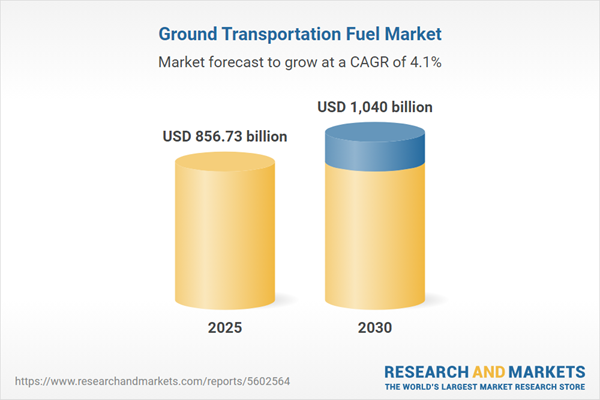Road transportation is the largest fuel market, accounting for 90% of global transportation fuel use (energy.gov). The importance of maritime and aviation fuel markets in supporting global trade should not be underestimated despite their relatively small size. Furthermore, each transportation sector favors a particular fuel quality linked to its performance and amount of reliance. People have started to opt for private transport over public transport as it includes more advantages in terms of comfort, less time to travel, and affordability.
The rising sales of automobiles worldwide are forecasted to boost the sales of global ground transportation fuel. With the increasing sales of automobiles across the globe, the demand for different types of fuels, like petrol, gasoline, CNG, and hydrogen, among others, will increase significantly. Similarly, the growing global crude oil production is also estimated to boost the ground transportation fuel market.
Ground transportation fuel market drivers
Increasing sales of automotive is propelling the market
A major factor propelling the global ground transportation fuel market is the increasing sales of automobiles worldwide. The International Organization of Motor Vehicle Manufacturers, or OICA, in its sales report, stated that global passenger vehicle sales increased. The organization stated that in 2021, the total sales of passenger automobiles were recorded at 57.276 million, which increased to 58.644 million in 2022. In 2023, the global sales of passenger automobiles increased to 65.272 million units.The report further stated that in 2023, the Asia/Oceania/Middle East region is among the biggest producers of automobiles, selling about 42.572 million units of passenger automobiles, whereas the sales of passenger vehicles in the European region reached 14.998 million. Similarly, in 2023, about 6.9 million units of passenger automobiles were sold in the American region.
Ground transportation fuel market geographical outlook
Asia Pacific is forecasted to hold a major share of the ground transportation fuel market.
The Asia Pacific region is estimated to attain a greater market share during the forecasted timeline. The Asia Pacific region is among the biggest producers of automotives across the globe. The sales of automobiles in the Asia Pacific region, especially in nations like India, China, Japan, and South Korea, increased massively over the past few years. The International Organization of Motor Vehicle Manufacturers (OICA), in its global sales report of 2023, stated that the sales of automobiles in Asia observed massive growth compared to the other regions.The organization stated that in China, about 21.518 million automobiles were sold in 2021, which increased to about 23.563 million in 2022 and 26.062 million in 2023. Similarly, in India, the sales of automobiles were recorded at about 3.082 million in 2021, which surged to 3.792 million in 2022. In 2023, a total of about 4.101 million automobile units were sold nationwide.
Reasons for buying this report::
- Insightful Analysis: Gain detailed market insights covering major as well as emerging geographical regions, focusing on customer segments, government policies and socio-economic factors, consumer preferences, industry verticals, other sub- segments.
- Competitive Landscape: Understand the strategic maneuvers employed by key players globally to understand possible market penetration with the correct strategy.
- Market Drivers & Future Trends: Explore the dynamic factors and pivotal market trends and how they will shape up future market developments.
- Actionable Recommendations: Utilize the insights to exercise strategic decision to uncover new business streams and revenues in a dynamic environment.
- Caters to a Wide Audience: Beneficial and cost-effective for startups, research institutions, consultants, SMEs, and large enterprises.
What do businesses use our reports for?
Industry and Market Insights, Opportunity Assessment, Product Demand Forecasting, Market Entry Strategy, Geographical Expansion, Capital Investment Decisions, Regulatory Framework & Implications, New Product Development, Competitive IntelligenceReport Coverage:
- Historical data & forecasts from 2022 to 2029
- Growth Opportunities, Challenges, Supply Chain Outlook, Regulatory Framework, Customer Behaviour, and Trend Analysis
- Competitive Positioning, Strategies, and Market Share Analysis
- Revenue Growth and Forecast Assessment of segments and regions including countries
- Company Profiling (Strategies, Products, Financial Information, and Key Developments among others)
The ground transportation fuel market is segmented and analyzed as follows:
By Type
- Diesel
- Gasoline
- Biofuel
- Natural Gas
- Others
By Vehicle Type
- Light Vehicle
- Heavy Vehicle
By Geography
- North America
- USA
- Canada
- Mexico
- South America
- Brazil
- Argentina
- Others
- Europe
- United Kingdom
- Germany
- France
- Italy
- Others
- Middle East and Africa
- Saudi Arabia
- Israel
- Others
- Asia Pacific
- China
- Japan
- India
- South Korea
- Indonesia
- Thailand
- Taiwan
- Others
Table of Contents
Companies Mentioned
- Occidental Petroleum Corporation
- Shell Plc
- Exxon Mobil
- British Petroleum Plc
- Chevron Corporation
- Total Energies
- Indian Oil Corporation Ltd
- Bharat Petroleum Corporation Limited
- Indraprastha Gas Limited
- Hindustan Petroleum Corporation Ltd.
- Adani Group
- Powergas
Table Information
| Report Attribute | Details |
|---|---|
| No. of Pages | 120 |
| Published | November 2024 |
| Forecast Period | 2025 - 2030 |
| Estimated Market Value ( USD | $ 856.73 billion |
| Forecasted Market Value ( USD | $ 1040 billion |
| Compound Annual Growth Rate | 4.1% |
| Regions Covered | Global |
| No. of Companies Mentioned | 12 |









